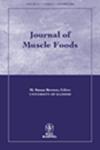MUSCLE FIBER TYPE AND THE OCCURRENCE OF PALE, SOFT, EXUDATIVE PORK
Abstract
ABSTRACT
Pale, soft, exudative (PSE) pork is a problem in the meat industry. Previous studies have shown that PSE pork results from accelerated postmortem muscle metabolism, perhaps related to a preponderance of type 2b muscle fibers. The present study further elucidates the role of fiber type complement in PSE pork. Immunocytochemical and histochemical techniques were used to characterize fibers as type 1, 2a, 2×or 2b in PSE and normal longissimus muscle. The number, size and percent of total muscle cross-sectional area of each fiber type were determined. No significant differences in size, number or percent of total area of any fiber type were found between PSE and normal pork. This suggests that the relative abundance of any given fiber type is not wholly responsible for the occurrence of PSE pork. Consistent with PSE water loss, however, the fibers from PSE pork were on average significantly smaller than those from normal pork.
PRACTICAL APPLICATIONS
Pale, soft and exudative (PSE) meat continues to be a major problem for the pork industry. The present study provides important insights into the role of muscle fiber type in this condition. Unlike many previous studies, we examine the presence of all four primary fiber types (1, 2a, 2× and 2b) in normal and PSE pork. We determine that the relative abundance of any given fiber type cannot be entirely responsible for the occurrence of PSE pork. Also the smaller average size of fibers from PSE pork is consistent with water loss from the tissue, and has the potential to be used as an additional criterion for identifying PSE pork.

 求助内容:
求助内容: 应助结果提醒方式:
应助结果提醒方式:


